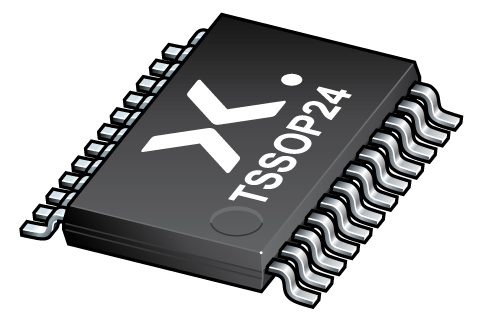Orderable parts
| Type number | Orderable part number | Ordering code (12NC) | Package | Buy from distributors |
|---|---|---|---|---|
| PCA9539PW | PCA9539PWJ | 935691435118 | SOT355-1 | Order product |

Register once, drag and drop ECAD models into your CAD tool and speed up your design.
Click here for more informationLow-voltage 16-bit I²C and SMBus low-power I/O expander with interrupt output, reset pin and configuration registers
The PCA9539 provides 16 bits of General Purpose Input/Output (GPIO) expansion with interrupt and reset for I²C-bus/SMBus applications. It is designed for a wide voltage range of 2.3 V to 5.5 V. Nexperia GPIO expanders provide an elegant solution when additional IOs are needed while keeping the interconnections to a minimum, for example, in ACPI power switches, sensors, push buttons, LEDs and fan control. The PCA9539 contains a set of 8 bit Input, Output, Configuration and Polarity Inversion registers. At power up all IOs default to inputs. Each IO can be configured as either input or output by changing the corresponding bit in the configuration register. The data for each input or output is stored in the corresponding input or output register. The polarity inversion register can be programmed to invert the polarity of the read register. The PCA9539 has an open-drain interrupt output which is activated when any one of the GPIO changes from its corresponding input port register state. INT can be connected to the interrupt input of a microcontroller. By sending an interrupt signal on this line, the remote I/O can inform the microcontroller if there is incoming data on its ports without having to communicate via the I²C-bus. Thus, PCA9539 can remain a simple slave. The power on reset sets the registers to default values and initializes the device state machine. The RESET pin can be used to achieve same reset functionality without power down/up cycling by keeping active low. The state machine and the registers are in their default state until the RESET input is once again HIGH. This input requires pull up to VCC. The PCA9539 has two address pins A0 and A1 which can be used to configure the I²C bus slave address of the device. It allows up-to four devices to share the same I²C-bus/SMBus.
I²C-bus to parallel port expander
Operating power supply voltage range of 2.3 V to 5.5 V
Ultra low standby current consumption:
1 µA (maximum)
Schmitt-trigger action allows slow input transition and better switching noise immunity at the SCL and SDA inputs
Vhys = 0.10 × VCC (typical)
Noise filter on SCL and SDA inputs
5 V tolerant I/Os
16 I/O pins which power up configured in input state
Open-drain active LOW interrupt output (INT)
Reset input (RESET) for resetting PCA9539 to default values
400 kHz Fast-mode I²C-bus
Internal power-on reset
No glitch on power-up
Latched outputs with 25 mA drive maximum capability for directly driving LEDs
Latch-up performance exceeds 100 mA per JESD78, Class II
ESD protection:
HBM: ANSI/ESDA/JEDEC JS-001 class 2 exceeds 2000 V
CDM: ANSI/ESDA/JEDEC JS-002 class C3 exceeds 1000 V
TSSOP24 package: plastic thin shrink small outline package; 24 leads; body width 4.4 mm
Specified from -40 °C to +85 °C
| Type number | Package name |
|---|---|
| PCA9539PW | TSSOP24 |
| Type number | Orderable part number, (Ordering code (12NC)) | Status | Marking | Package | Package information | Reflow-/Wave soldering | Packing |
|---|---|---|---|---|---|---|---|
| PCA9539PW | PCA9539PWJ (935691435118) |
Active | PCA9539PW |

TSSOP24 (SOT355-1) |
SOT355-1 |
SSOP-TSSOP-VSO-WAVE
|
SOT355-1_118 |
| Type number | Orderable part number | Chemical content | RoHS | RHF-indicator |
|---|---|---|---|---|
| PCA9539PW | PCA9539PWJ | PCA9539PW |
|
|
| File name | Title | Type | Date |
|---|---|---|---|
| PCA9539 | Low-voltage 16-bit I²C and SMBus low-power I/O expander with interrupt output, reset pin and configuration registers | Data sheet | 2024-08-01 |
| AN90063 | Questions about package outline drawings | Application note | 2025-10-22 |
| SOT355-1 | 3D model for products with SOT355-1 package | Design support | 2020-01-22 |
| pca9539 | PCA9539 IBIS model | IBIS model | 2014-08-13 |
| Leaflet_SOT8065_Minilogic | Leaflet_SOT8065 Minilogic | Leaflet | 2024-11-15 |
| Nexperia_package_poster | Nexperia package poster | Leaflet | 2020-05-15 |
| SOT355-1 | plastic, thin shrink small outline package; 24 leads; 0.65 mm pitch; 7.8 mm x 4.4 mm x 1.2 mm body | Package information | 2024-11-15 |
| SOT355-1_118 | TSSOP24; Reel pack for SMD 13''; Q1/T1 product orientation | Packing information | 2020-04-21 |
| PCA9539PW_Nexperia_Product_Reliability | PCA9539PW Nexperia Product Reliability | Quality document | 2023-05-29 |
| SSOP-TSSOP-VSO-WAVE | Footprint for wave soldering | Wave soldering | 2009-10-08 |
If you are in need of design/technical support, let us know and fill in the answer form we'll get back to you shortly.
The Nexperia Longevity Program is aimed to provide our customers information from time to time about the expected time that our products can be ordered. The NLP is reviewed and updated regularly by our Executive Management Team. View our longevity program here.
| Type number | Orderable part number | Ordering code (12NC) | Status | Packing | Packing Quantity | Buy online |
|---|---|---|---|---|---|---|
| PCA9539PW | PCA9539PWJ | 935691435118 | Active | SOT355-1_118 | 2,500 |
|
As a Nexperia customer you can order samples via our sales organization.
If you do not have a direct account with Nexperia our network of global and regional distributors is available and equipped to support you with Nexperia samples. Check out the list of official distributors.
The interactive datasheets are based on the Nexperia MOSFET precision electrothermal models. With our interactive datasheets you can simply specify your own conditions interactively. Start by changing the values of the conditions. You can do this by using the sliders in the condition fields. By dragging the sliders you will see how the MOSFET will perform at the new conditions set.